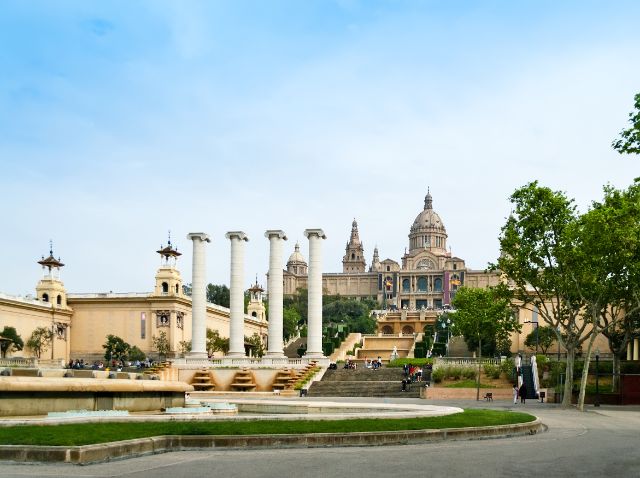- Home
- Where2Go
- Places
- Barcelona
- Places to visit in Barcelona
- Museu Nacional d'Art de Catalunya
Museu Nacional d'Art de Catalunya
BarcelonaWorld’s Best Romanesque Murals

Overview
The museum was constructed for the International Exposition of 1929 in the National Palace of Montjuïc. The National Art Museum of Catalunya is known for its medieval and contemporary collection from middle ages to the 20th century.
Suggested Duration - 1-2 hours
What To Expect?
The highlight of the museum is the extraordinary collection of Romanesque frescoes, woodcarvings and painted altar frontals. Head to the upper floor through the beautiful domed hall to see the modern art collection displayed there.
Tips
- Look for the works from other Spanish and Mediterranean regions in the Gothic art section.
- Make way to the recently launched Renaissance & Baroque gallery for the flair of Spanish artists.
- Don’t miss the Modernista furniture and decoration, which include chairs by Gaudí and a mural by Ramon Casas.
- Catch a surreal bird-eye view of Barcelona from the terrace at sunset.
- Feast on delicious snacks at the museum restaurant Òleum with stunning views.
- Book online a combined ticket that comes along an audio-guide at €14. Entry is free for children up to 16 years of age.
More About Museu Nacional D'Art De Catalunya!
Museu Nacional d’Art de Catalunya, Barcelona Overview –
Nestled in the heart of Barcelona, the Museu Nacional d'Art de Catalunya (MNAC) is a treasure trove of artistic masterpieces spanning over a thousand years. Established in 1934, this iconic museum is housed in the majestic Palau Nacional, a stunning example of 20th-century architecture. The museum is renowned for its extensive collection of Romanesque, Gothic, Renaissance, and Baroque art, as well as modern art and photography. Visitors can marvel at the works of renowned artists such as El Greco, Velázquez, Gaudí, and Picasso, among others. With its rich history, diverse exhibits, and breathtaking views of the city, the Museu Nacional d'Art de Catalunya is a must-visit destination for art enthusiasts and tourists alike.
| Museu Nacional d’Art de Catalunya is Known For | Its vast collection of Romanesque, Gothic, Renaissance, and Baroque art, as well as modern art and photography. |
|---|---|
| Timings | Tuesday to Saturday: 10:00 am to 6:00 pm Sundays and public holidays: 10:00 am to 3:00 pm Closed on Mondays |
| Ticket Prices | General admission is €12, with various discounts available for students, seniors, and groups. |
| Tips | Purchase tickets online to avoid queues. Consider visiting on the first Sunday of the month for free entry. |
| Required Time | Allocate at least 3-4 hours to fully explore the museum. |
| Restricted Items | Large bags, umbrellas, and tripods are not allowed inside the museum. |
More About Museu Nacional d’Art de Catalunya
The Museu Nacional d'Art de Catalunya boasts an impressive collection of over 290,000 works, making it one of the largest museums in Spain. The museum's Romanesque collection is particularly noteworthy, featuring a unique ensemble of mural paintings and wooden sculptures. The Gothic art section showcases exquisite altarpieces, while the Renaissance and Baroque collections display works by renowned European artists. The museum also houses an extensive collection of modern art, including Catalan Modernism, Noucentisme, and avant-garde movements. Additionally, the museum hosts temporary exhibitions, educational programs, and cultural events throughout the year.
Architecture of Museu Nacional d�Art de Catalunya -
The museum is housed in the Palau Nacional, a magnificent building designed by architects Eugenio Cendoya and Enric Catà for the 1929 International Exposition.
How to Reach Museu Nacional d�Art de Catalunya -
The museum is easily accessible by metro (L1 and L3), bus (55 and 150), and the FGC train (L8, S33, S4, and S8).
Tips for Visiting Museu Nacional d�Art de Catalunya -
Wear comfortable shoes, as the museum is quite large; consider using the audio guide for a more immersive experience.
Nearby Tourist Spots
- Magic Fountain of Montjuïc:A mesmerising display of water, light, and music, creating a captivating spectacle for visitors of all ages.
- Poble Espanyol:A unique open-air architectural museum, showcasing the diverse styles and traditions of Spanish regions in a charming village setting.
- CaixaForum Barcelona:A contemporary cultural centre housed in a stunning modernist building, offering a variety of exhibitions, workshops, and events.
- Olympic Stadium:An iconic sports venue built for the 1992 Summer Olympics, offering a glimpse into Barcelona's sporting history and achievements.
FAQs - Frequently Asked Questions about Museu Nacional d'Art de Catalunya
How do you plan for the perfect trip to any destination?
How to choose a destination to travel to?
How to explore a place by yourself?